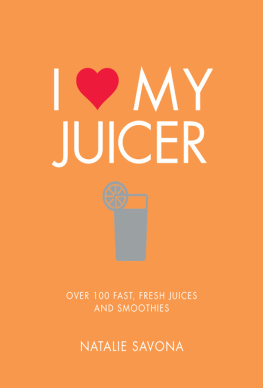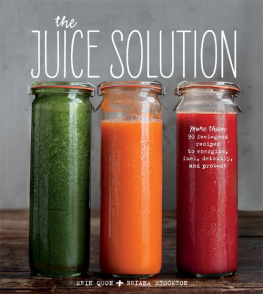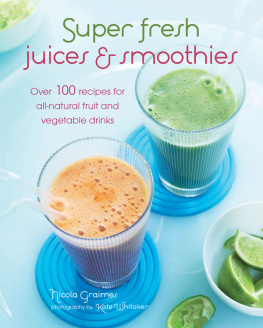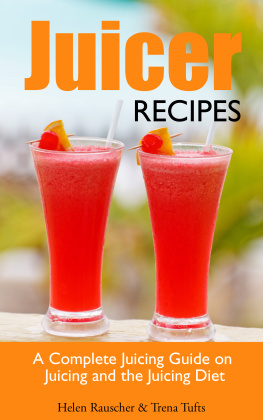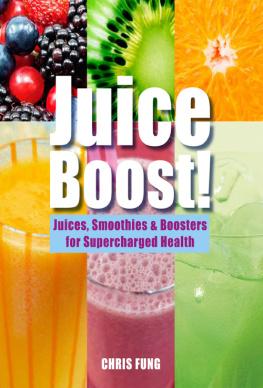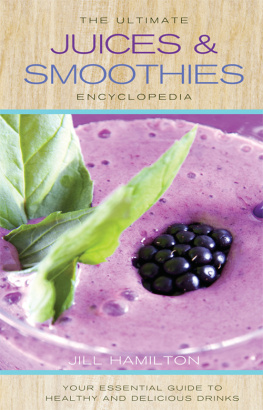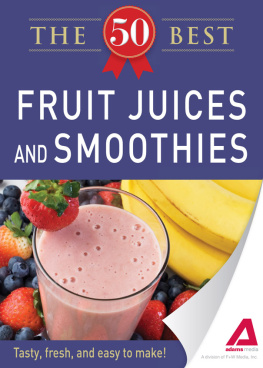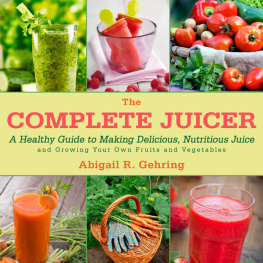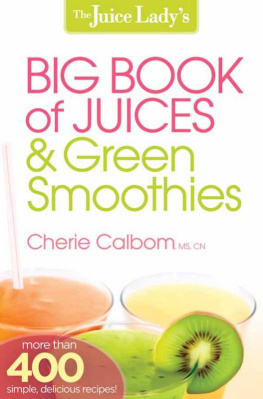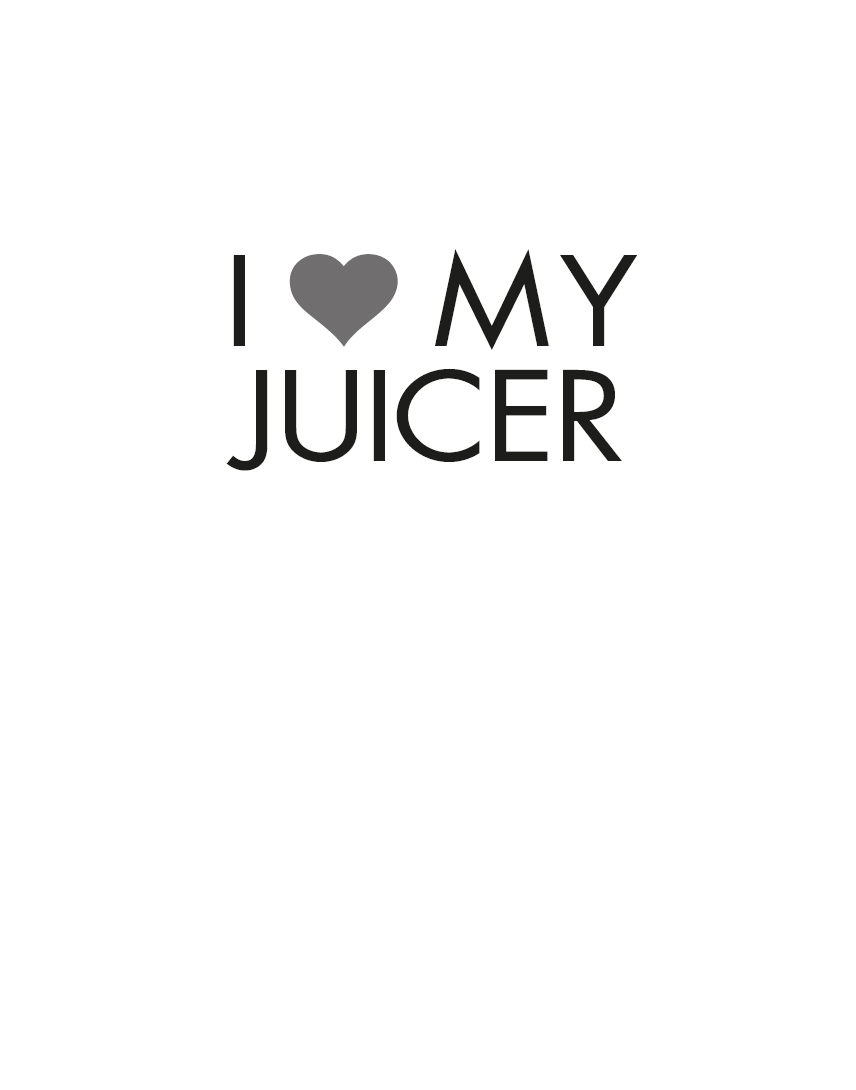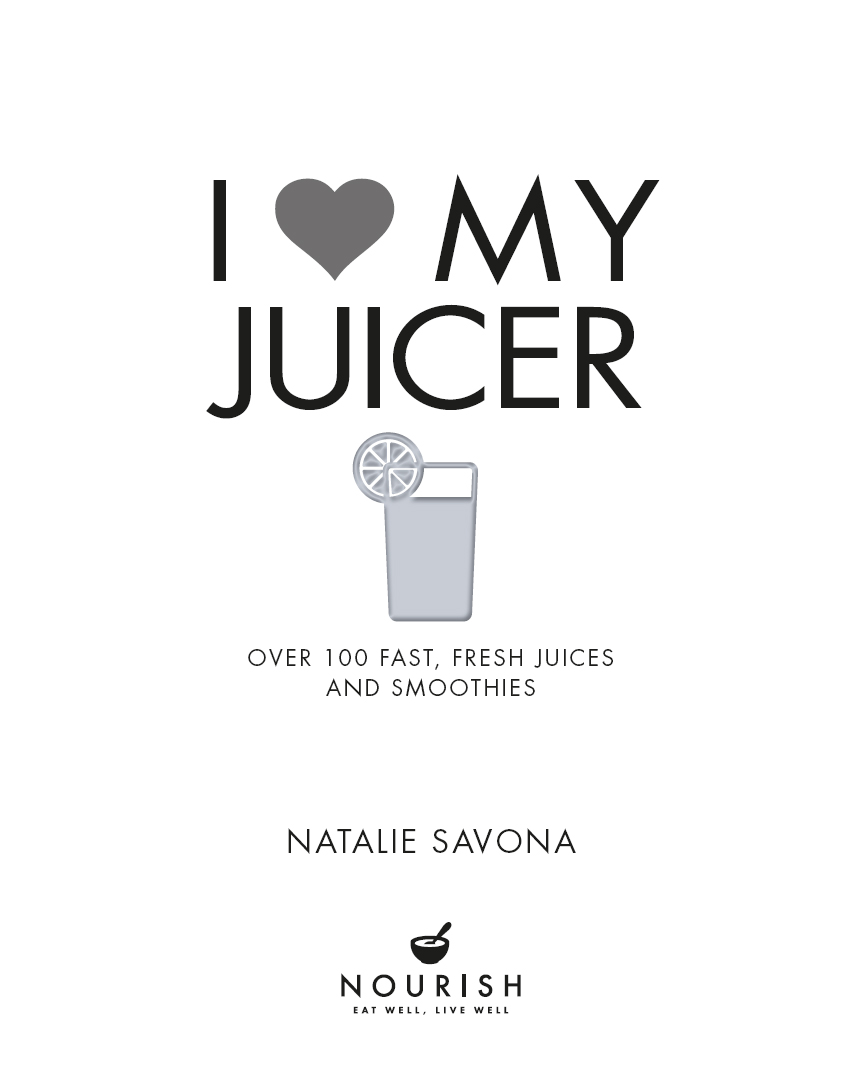CONTENTS
INTRODUCTION
Unlike much of what we eat and drink today, juices and smoothies both taste sensational and are supremely good for you. Raw fruits and vegetables are laden with vitamins, minerals, enzymes and other ingredients that give us a boost in energy, ward off illness and keep our bodies cleansing processes working optimally, which is reflected in our skin.
Once youve developed the habit of making your own fresh juice, nothing else will do. So to inspire you to keep it fresh and interesting, this book gives you five chapters of delicious, health-boosting juice and smoothie recipes. All the information you need about the specific health benefits and nutrients of each drink is listed on the individual recipes, too.
If youre juicing because youre under the weather, have a look at the Juice Therapy section on pages .
WHY JUICE?
Raw, fresh juice is one of the most health-affirming, rejuvenating substances we can take. Drinking a fresh juice provides the body with nutrients on a superhighway its a fast delivery of vitamins, minerals, enzymes, carbohydrates, chlorophyll and countless other phytonutrients (nutrients derived from plants), which are shown to boost health. And all of this contained in pure, fresh water.
These nutrients enhance immunity, helping to protect us from not just colds and coughs but also cancer and cardiovascular disease, too. Juices are powerhouses of antioxidants nutrients such as vitamins A, C and E that fight oxidants (sometimes called free radicals) in our bodies that contribute to cancer, heart disease and ageing. Green juices, of course, add another dimension, as substances such as green chlorophyll are particularly cleansing.
Everyone knows that we are supposed to have at least five servings of fruit and vegetables each day. Officially, though, a glass of juice no matter how many different fruits or vegetables are in it counts as a single portion, although a fresh, unadulterated, homemade juice, drunk straight from the jug, easily rates higher nutritionally than the average shop-bought juice.
So, in drinking your daily juice, you are not only fuelling yourself with energy, but also supporting your bodys natural cleansing processes and helping stave off all manner of diseases. A homemade juice stands in a league of its own compared with most other drinks, such as off-the-shelf processed juices, not to mention coffee, tea, cordials, fizzy and so-called energy drinks. It is simply the best liquid refreshment that a body can have.
JUICE OR SMOOTHIE?
Is it a juice, or is it a smoothie? Put simply, a juice is made using a special juice extractor or citrus press, while a smoothie is made by reducing whole ingredients to a pulp in a blender seeds, pith and all. Some of the smoothies in this book are thick and creamy not just because they are blended fruit but because of the addition of yogurt or because the fruit used is frozen, or the drinks are super cold and refreshing because of the addition of ice and sparkling water.
There is also a great deal of difference in the consistency and properties of the end products. With a juice you are getting just that the liquid from the fruit or vegetable after it has been pushed through the extractor or press and the fibre and pulp is left behind. Because a smoothie is made by simply blending the fruit to a pulp, you get the whole fruit, which means that a smoothie can be a meal in itself.
There are particular benefits associated with both juices and smoothies. Juices provide nutrients at top speed our body absorbs their goodness with maximum efficiency, unhindered by any need to break down and digest bulkier foodstuffs. The lack of any fibre (left behind in the extractor during the juicing process) means that our body can assimilate the nutrients from a juice in a matter of minutes rather than hours. This is a sure-fire way of getting the most of the vitamins, minerals, enzymes, cleansing elements and other nutritional goodness from a fruit or vegetable.
Unlike juices, smoothies contain a good amount of fibre, an important nutrient in itself that is all too often lacking in our diet. Not only does fibre help to keep our gut moving, but it also helps it to stay healthy and to maintain the right levels of good bacteria.
In addition to this, any drink made using yogurt or milk, such as our creamy smoothies, becomes an important source of protein, which is another essential element of a healthy diet.
GETTING READY
EQUIPMENT
To make a variety of the recipes from this book you will need a juice extractor, a citrus press and a blender but not all at once! Straight juices can be made using a juice extractor alone. There is a huge range of juicers and blenders on the market, with new ones being introduced all the time, so rather than suggest specific brands, here are some general guidelines to help you make the decision about what you should buy to suit your needs:
When choosing your first juicer, buy one at the lower end of the price range you can upgrade it when you get the juicing bug. If you have the cash, the more expensive machines can be a good investment, as they last a long time.
Most juicers are what are called centrifugal extractors, which means they grate the fruit and quickly spin it out toward a mesh that catches and diverts away the pulp, sending the juice down into a jug. These are great value, very efficient and the fastest way to juice. However, the heat produced as the machine blitzes the fruit can destroy some heat-sensitive nutrients. They can also struggle a bit with softer ingredients such as greens and wheatgrass.
Masticating juicers, also known as cold press or slow juicers, can crush any ingredient hard or soft but do so slowly. These juicers have a tougher motor, and because they grind the ingredients more slowly, they press out every last bit of goodness.
All juicing machines have a couple of compartments that need cleaning immediately to remove pulp and clear out the extractor filters to ensure efficient working as well as for hygiene reasons. This can be a pain, but theres no way round it as all machines will need cleaning. Some machines will have dishwasher-safe parts, which helps a little, and most come with special brushes for scrubbing the mesh filters.
Citrus presses are best for citrus fruits as they can clog up a juicer. They are available as dishes with a central structure around which you squeeze halved fruit, as hand-held squeezers or as other press gadgets. These are great for when you just want to juice a small amount of citrus fruit perhaps to add to other ingredients in a blender and dont want to use a whole juicing machine.
The essential piece of smoothie kit is a blender. Most kitchens already have one, though often little-used, but, again, you can buy one quite cheaply. They are multipurpose so that you can use them for soups, sauces and more. When using a blender, all food must first be prepared properly to remove skin, seeds and cores because basically, what goes in will come out. Make sure that your blender can cope with harder ingredients such as nuts or ice, too, which will help you make thicker or chilled drinks. There are now many different types of blenders on the market, from the larger stand versions to the more compact ones, or personal blenders.

